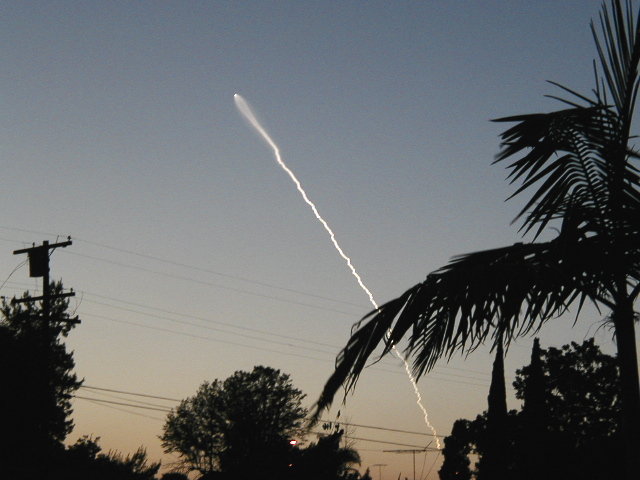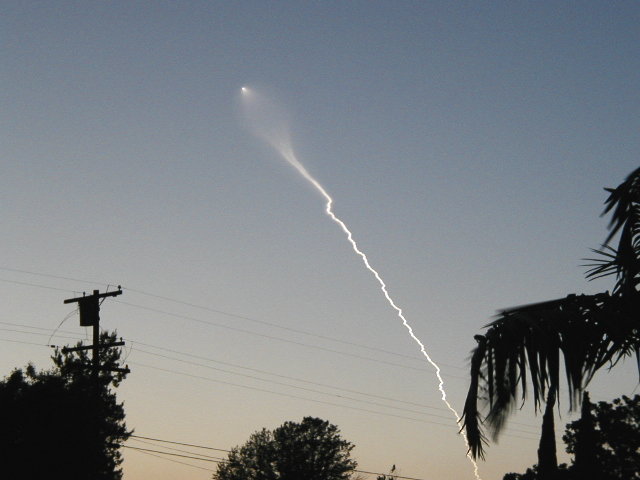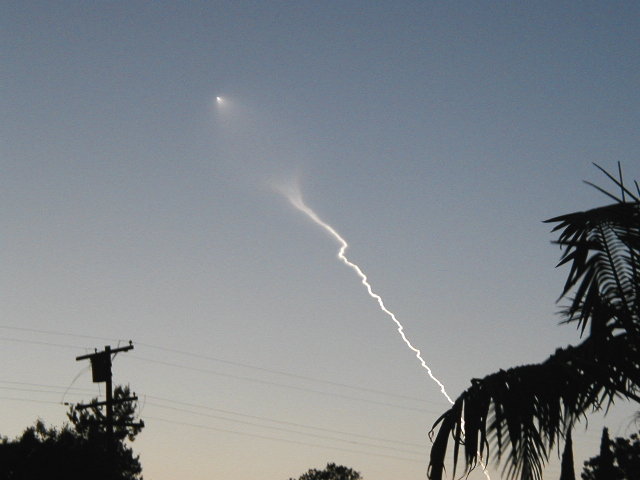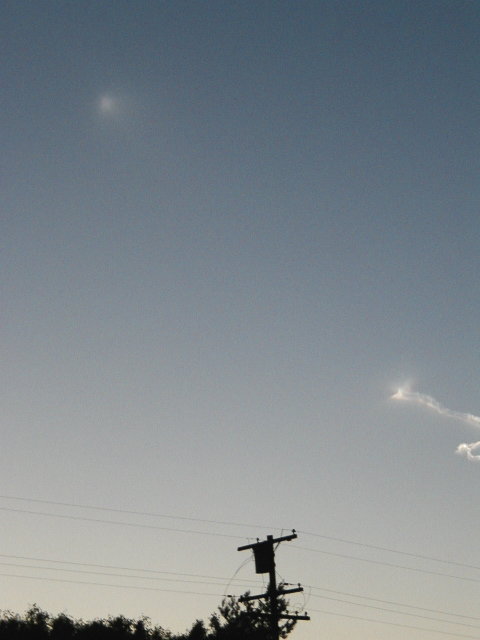President Bush Directs Initial Missile Defense Deployed...And A Successful March, 2002 Test From Vandenberg AFB Was Visible From LB
(December 17, 2002) -- President George W. Bush today directed the Defense Dept. to begin fielding "an initial set of missile defense capabilities" with plans "to begin operating these initial capabilities in 2004 and 2005, and they will include ground-based interceptors, sea-based interceptors, additional Patriot (PAC-3) units, and sensors based on land, at sea, and in space." (details below)
This means LB residents may well have witnessed history in March, 2002 when a missile defense system test from central CA's Vandenberg AFB was clearly visible in LB, with photos (below) captured by us.
Today, the Department of Defense (DoD) indicated that the initial set of defensive capabilities planned for 2004-2005 will include up to 20 ground-based interceptors capable of intercepting and destroying ICBM missiles during the midcourse phase of flight. These will be located at Ft. Greely, Alaska (16 interceptors) and central California's Vandenberg Air Force Base. (4 interceptors). (details below)
LBReport.com posts below excerpts of our March 15, 2002 report as well as today's DoD and White House releases:
March 15, 2002
Backlit in the post sunset glow, the photos speak for themselves. Bright spot appears to include payload with mock warhead
Less than three hours later, the Pentagon announced the test was successful. [end LBReport.com March 15, 2002 excerpts] When I came to office, I made a commitment to transform America's national security strategy and defense capabilities to meet the threats of the 21st century. Today, I am pleased to announce that we will take another important step in countering these threats by beginning to field missile defense capabilities to protect the United States, as well as our friends and allies. These initial capabilities emerge from our research and development program and build on the test bed that we have been constructing. While modest, these capabilities will add to America's security and serve as a starting point for improved and expanded capabilities later, as further progress is made in researching and developing missile defense technologies and in light of changes in the threat. September 11, 2001 underscored that our Nation faces unprecedented threats, in a world that has changed greatly since the Cold War. To better protect our country against the threats of today and tomorrow, my Administration has developed a new national security strategy, and new supporting strategies for making our homeland more secure and for combating weapons of mass destruction. Throughout my Administration, I have made clear that the United States will take every necessary measure to protect our citizens against what is perhaps the gravest danger of all: the catastrophic harm that may result from hostile states or terrorist groups armed with weapons of mass destruction and the means to deliver them. Missile defenses have an important role to play in this effort. The United States has moved beyond the doctrine of Cold War deterrence reflected in the 1972 ABM Treaty. At the same time we have established a positive relationship with Russia that includes partnership in counterterrorism and in other key areas of mutual concern. We have adopted a new concept of deterrence that recognizes that missile defenses will add to our ability to deter those who may contemplate attacking us with missiles. Our withdrawal from the ABM Treaty has made it possible to develop and test the full range of missile defense technologies, and to deploy defenses capable of protecting our territory and our cities. I have directed the Secretary of Defense to proceed with fielding an initial set of missile defense capabilities. We plan to begin operating these initial capabilities in 2004 and 2005, and they will include ground-based interceptors, sea-based interceptors, additional Patriot (PAC-3) units, and sensors based on land, at sea, and in space. Because the threats of the 21st century also endanger our friends and allies around the world, it is essential that we work together to defend against them. The Defense Department will develop and deploy missile defenses capable of protecting not only the United States and our deployed forces, but also our friends and allies. The United States will also structure our missile defense program in a manner that encourages industrial participation by other nations. Demonstrating the important role played by our friends and allies, as part of our initial missile defense capabilities, the United States will seek agreement from the United Kingdom and Denmark to upgrade early-warning radars on their territory. The new strategic challenges of the 21st century require us to think differently, but they also require us to act. The deployment of missile defenses is an essential element of our broader efforts to transform our defense and deterrence policies and capabilities to meet the new threats we face. Defending the American people against these new threats is my highest priority as Commander-in-Chief, and the highest priority of my Administration. MISSILE DEFENSE OPERATIONS ANNOUNCEMENT In light of the new security environment and progress made to date in missile defense development efforts, the President has directed the Department of Defense to begin fielding initial missile defense capabilities in 2004-2005 to meet the near-term ballistic missile threat to our homeland, our deployed forces, and our friends and allies. This initial capability will build on the planned Pacific Missile Defense Testbed and serve as a starting point for fielding improved, layered missile defense capabilities later. The Department of Defense is employing an evolutionary approach to the development and deployment of missile defenses over time. This means there is no final or fixed missile defense architecture. Rather, the composition of missile defenses, including the number, type, and location of systems deployed, will change over time to meet the changing threat and take advantage of technological developments. This approach includes the use of prototype and test assets to provide early capability, while improving the effectiveness of defensive capabilities over time. The initial set of capabilities planned for 2004-2005 will include: These initial capabilities may be improved through additional measures, such as: Because the threats of the 21st century also endanger our friends and allies around the world, it is essential that we work together to meet these threats. The Department of Defense plans to develop and deploy missile defenses capable of protecting not only the United States and our deployed forces, but also friends and allies. The missile defense program will also be structured in a manner that encourages industrial cooperation by friends and allies, consistent with overall U.S. national security. In conjunction with the Department of State, the Department of Defense will promote international missile defense cooperation, including within existing mutual defense structures like NATO, and negotiate appropriate arrangements for this purpose. The deployment of missile defenses is an essential element of our overall national security policy to transform U.S. defense and deterrence capabilities to meet emerging and evolving threats. The evolutionary approach to missile defense provides near-term capability to address the emerging ballistic missile threat and will evolve by the end of the decade into a multi-layered missile defense system capable of providing protection against the full range of limited ballistic missile attacks. This approach is flexible enough to provide defense for the United States and its friends and allies and, by reducing an adversary's confidence in ballistic missiles, can help deter the use of missiles and dissuade countries from acquiring these capabilities at the outset. |





 At roughly 6:11 p.m., a brilliant white plume streaked from the horizon toward the sky in the west/northwest at terrific speed. We grabbed our digital camera and started shooting.
At roughly 6:11 p.m., a brilliant white plume streaked from the horizon toward the sky in the west/northwest at terrific speed. We grabbed our digital camera and started shooting. The pictures on this page were taken by us from the Los Cerritos area at the Wardlow Road/Pacific Avenue Blue Line station (where we happened to be dropping someone off).
The pictures on this page were taken by us from the Los Cerritos area at the Wardlow Road/Pacific Avenue Blue Line station (where we happened to be dropping someone off). The missile, launched from Vandenberg AFB, carried the target: a mock warhead and balloon decoys.
The missile, launched from Vandenberg AFB, carried the target: a mock warhead and balloon decoys. The target payload, a brilliant spot in early photos, grows fuzzy...
The target payload, a brilliant spot in early photos, grows fuzzy... ...then disappears (leaving only missile contrail, far right.) Based on the chronology in the DOD press release, the intercept occurred at roughly 6:40 p.m. (about 20 minutes after our final picture was taken.)
...then disappears (leaving only missile contrail, far right.) Based on the chronology in the DOD press release, the intercept occurred at roughly 6:40 p.m. (about 20 minutes after our final picture was taken.)